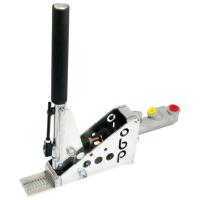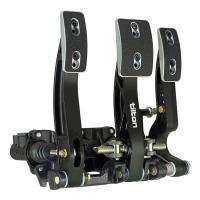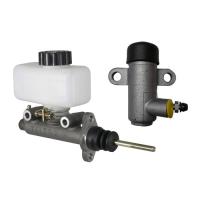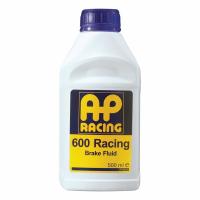History of Hydraulics, Brake System Hydraulics, Hydraulic System Performance and Pedal and Hydraulic Ratios
History of Hydraulics
The term Hydraulics comes from two separate Greek words referring to water and pipe. As far back as the 6th century BC, the behavior of water and its flow through pipes has been studied.
The father of modern Hydraulics is French mathematician Blaise Pascal (1623 - 1662). Pascal established Pascal's Law and is the namesake of the SI unit for pressure, the Pascal (Pa).
Pascal's law states 'a change in pressure at any point in an enclosed fluid at rest is transmitted undiminished to all points in the fluid.' In Pascal's 1646 barrel experiment, he fitted the top of a barrel with a long vertical pipe. While this barrel would have no problem containing the pressure of the fluid it would take to fill it, the additional pressure from the weight of the fluid in the tube attached to the barrel would cause it to eventually leak due to the increase in pressure.
Mathematically, Pascal found the amount of pressure resulting from this column of fluid would be a function of the height of the column and the density of the fluid. Later experiments with U-tubes filled with water with varying size pistons and tube diameter’s led to the invention of the Hydraulic press.
Brake System Hydraulics
The hydraulic brake system on a vehicle starts at the master cylinder and ends at the calipers. The master cylinder is responsible for establishing the amount of pressure in the brake lines and calipers. A mechanical lever, known as the brake pedal, accepts a mechanical force input from the driver’s foot.
The force causes a push-rod to push the piston assembly within the master cylinder. In turn, the master cylinder increases the pressure in the hydraulic brake system. This increase in pressure exerts additional force on the calipers to squeeze the brake pads to the rotors.
Any portion of the brake system that carries the hydraulic brake fluid is part of brakes hydraulic system. This includes master cylinders, hard brake lines, proportional valve, flexible brake lines, race car bias pedal box and calipers.
Race Car Hydraulic System Performance
If you have ever changed a master cylinder, brake line or caliper on a vehicle, you are probably quite familiar with how air trapped in the brake's hydraulic system affects its performance. A spongy pedal or brakes that simply don’t work are usually the result of air getting into the hydraulic system. Proper bleeding of the system to remove the air from the system restores the functionality of the hydraulics.
While brake fluid and its incompressible nature do an excellent job of transferring a pressure increase across the entire system, air simply compresses and fails to transmit the effort put in at the pedal.
Since most of today’s vehicles incorporate an ABS system into the hydraulics, its important to follow the vehicle manufacturers recommendation’s for bleeding the system. In most cases, bleeding is started at the caliper furthest from the master cylinder. Using a suction type bleeder can be helpful in removing stubborn air pockets from the brake system.
Hydraulic Ratios
On a factory vehicle, a group of engineers determine the exact amount of pedal travel and pedal resistance they desire for the driver. By varying the bore size of the master cylinder, the pedal ratio and the total piston area of the caliper’s pistons, engineers establish total pedal travel and pedal effort.
The amount of travel that OEM’s set generally pretty long with ABS system activation occurring a couple inches off the floor in a properly working system. A long pedal travel minimises effort while maximising modulation (the ability to vary the degree of braking applied).
For a racing application, there may be a desire to shorten the pedal travel to allow full braking power to come sooner. One way to accomplish this is to change the master cylinder to replacement featuring a large piston and bore area. While this will reduce the pedal travel, it will come at the cost of reduced modulation and increased effort.
Of course braking systems feature some type of assist (vacuum or electric), may not reveal the increase in pedal effort in full. Conversely changing to a master cylinder with a smaller bore will result in increased pedal travel, decreased effort and improved modulation.
Motorsport Tech Session - TOP TIPS
Pedal effort is directly proportional to the amount of pressure created in the hydraulic braking system peak pressure will reach between 600 and 1200 psi.
A stroke of about 25 - 35 mm at the master cylinder should be needed to reach the peak pressure.
The bore diameter of the master cylinder, the pedal ratio, the total area of all the calipers pistons and the pressure in the brake system all influence the pedal effort.
These also influence the amount of travel required to reach the peak pressure.
TO INCREASE PEDAL EFFORT:
Increase Master Cylinder Diameter Choose Lower Pedal Ratio
Remove or Decrease Brake Assist
TO DECREASE PEDAL EFFORT:
Decrease Master Cylinder Diameter Choose Higher Pedal Ratio
Add or Increase Brake Assist.
Three factors influence the line pressure in the brake system: the pedal force, the pedal ratio and the master cylinder bore sizes.
About 100 to 150 pounds of force from the leg to the pedal is a good working range.
The pedal ratio multiplies this effort.
For example a 5.2:1 pedal ratio would multiply a 100-pound pedal force to 520 pounds force going into the master cylinder. With a 13/16 bore (area=0.5185) the pressure in the system would be 520/0.5185 or 1003 psi.
IF YOU INCREASE MASTER CYLINDER BORE DIAMETER:
Increase Pedal Effort
Decreases Total Pedal Travel
Reduced Push-rod Stroke to Master Cylinder Decreases Line Pressure for a Given Pedal Force
IF YOU DECREASE MASTER CYLINDER BORE DIAMETER:
Decrease Pedal Effort
Increases Total Pedal Travel
Increases Push-rod Stroke to Master Cylinder Increases Line Pressure for a Given Pedal Force







